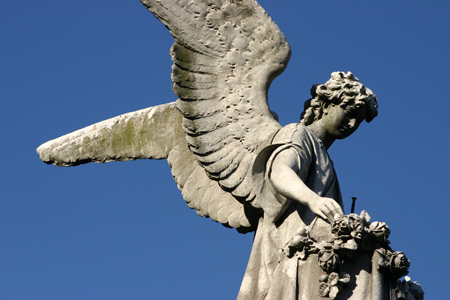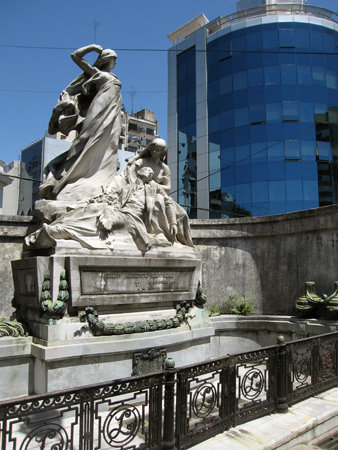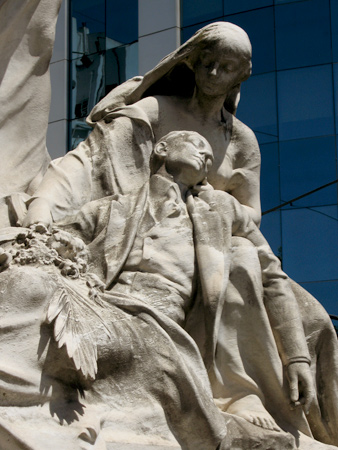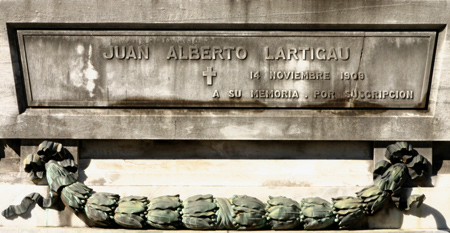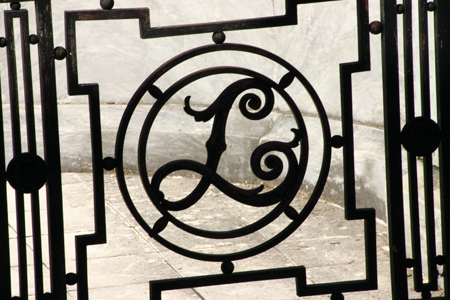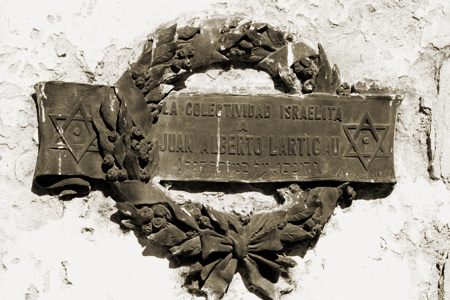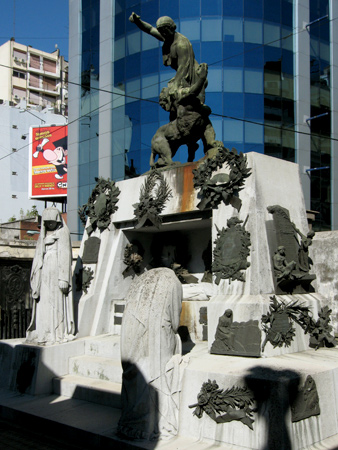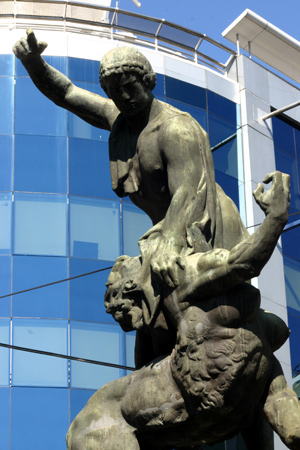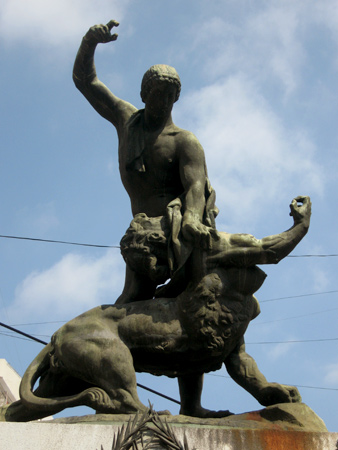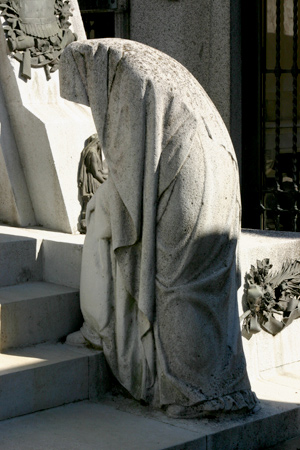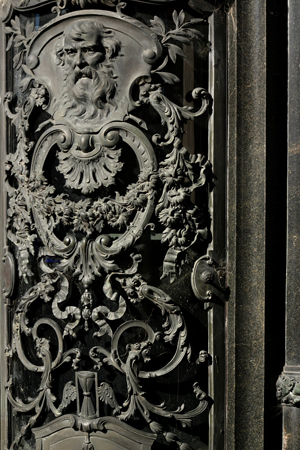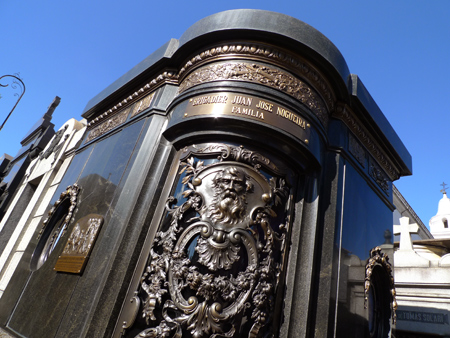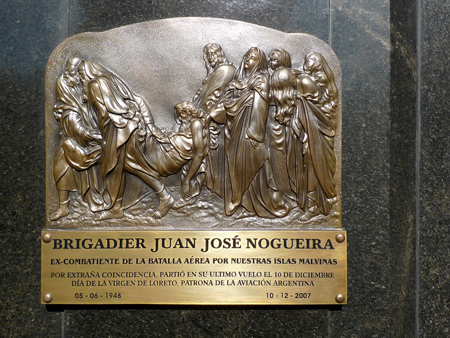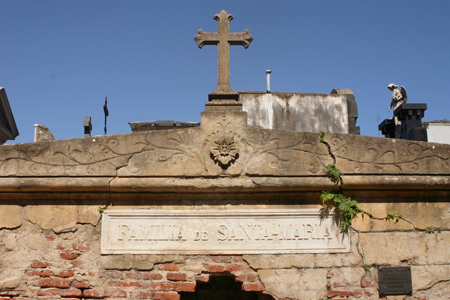Written before tourism took off in Argentina, this interesting piece by Barbara Cansino skillfully avoids many of the clichés found in more recent articles about Recoleta Cemetery. It’s also interesting to see how things have changed since then:
“In Buenos Aires the elegant neighborhood of Recoleta is the fashionable place to stay, to while away hours in cafes and museums, to walk the poodles in the park. And when it’s all over, it’s the place to end up. Across the grassy way from the outdoor cafes, a great white portal marks the most exclusive address of all: Cementerio de la Recoleta, Recoleta Cemetery, burial place of Argentina’s elite. Here patricians and presidents, heroes and heroines, rest in astonishing grandeur.
Mausoleums built side by side resemble Greek temples, Gothic chapels, Egyptian pyramids, fairytale grottoes, postmodern boutiques — or just elegant little houses. They have marble steps, wrought-iron doors, appointed interiors. There are marble Saviours and Madonnas and sculptures of the departed and their pets. The city skyline gives way to palm trees and cypresses, crosses and steeples, busts and domes, great stone angels reaching to heaven. The mausoleums can cost the earth. And the earth they are on, occupied by generations of the high-born departed, is the scarcest — and costliest — land in the country.
Recoleta Cemetery is one of the world’s extraordinary graveyards, a study in architecture and sculpture, a country’s history, mores and soul. A number of tombs are national historic monuments. It is a place of spiritual beauty and extravagant taste. And thanks to Madonna and Broadway, it is hotter than ever as a tourist attraction. Travelers stream through the portal, cameras in hand, and ask the custodians the way to ”Evita.” Some even ask for ”Madonna.”
Evita’s tomb says ”Familia Duarte,” her maiden name, and — with a simple black facade on a narrow side street — is nothing special by Recoleta standards. The masses of flowers, however, the crowds of visitors and the fact that she is there in the first place — surrounded by the rich she despised and who despised her — are ironic. In this enclave of wealth, with tomb inscriptions from national banks and the elite Jockey Club, the plaques to Evita are from the Buenos Aires Taxi Drivers Union or the General Confederation of Labor, an umbrella organization of unions. The inscription in Spanish on the latter plaque ends with her battle cry, first used by Spartacus in leading a slave revolt against the Romans:
”. . .I keep the hope for glory,
I wish only to serve
The humble and the workers”
I will come back and I will be millions. . . !
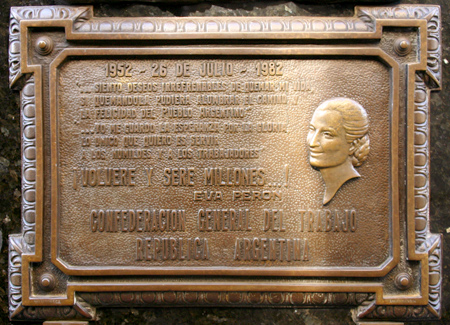
On a given Monday there are three huge floral arrangements at her tomb. Carnations, roses and fuchsia are stuck in the door wherever there’s space. Fourteen people are crowded three deep, most of them tourists, posing for photos in front of the plaques, discussing why they are there.
A curator from Bilbao: ”I visit cemeteries. In Paris I go to see Oscar Wilde. Here I came to see [Domingo] Sarmiento, one of the fathers of the country, and Eva Peron, who worked for the poorest of the country. She was a myth who overshadowed Peron.” A tourist from Dallas: ”I saw the musical five times in Los Angeles.” A British Airways flight attendant: ”Argentina’s not Argentina without Eva Peron, is it? And I thought Madonna, the actress who portrayed her, should have won an award from the Academy.” And, on a quiet weekday morning, away from the fray, an old woman with no teeth and holes in her shoes stops at the tomb, touches Evita’s face on a plaque, deposits a bunch of daisies and prays.
Evita aside, the main attractions of Recoleta are the architecture, the grandiose aura, the sense of rubbing shoulders with Argentine history. The cemetery, inaugurated in 1822 and redesigned in 1881, encompasses 13.5 acres. The departed include Argentine presidents and vice presidents, governors, generals, admirals, industrialists, publishers, judges, doctors, professors, writers, poets, scientists — and their families. Some of them — Alvear, Dorrego, Pueyrredon — are familiar from the Buenos Aires streets and plazas that bear their names. Others, such as Jose Estrada, are known from the Literature of Argentina shelves in bookshops. Still others, such as Dufour, Barchiesi, O’Shea, Zoltowska or Breitman, reflect the many facets of Argentine society…”
The original article, along with two more pages of text, can be found here. The above photo is by the post author.
Leave a Comment